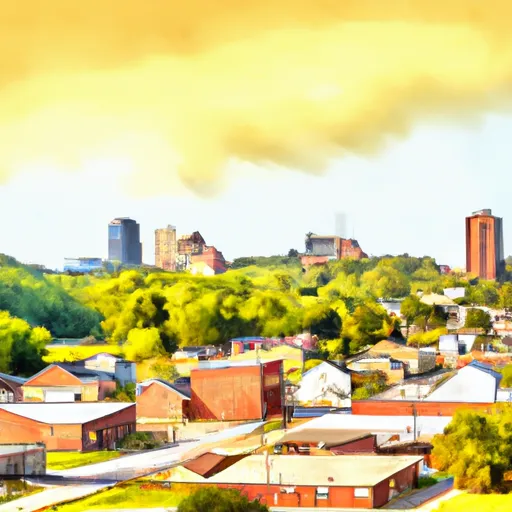-
 Snoflo Premium
Snoflo Premium
Get unlimited access to all our content
With no Ad interruptions! - Start Your Free Trial Login with existing account
Wallins-Creek
Eden Index
Climate
7.9
•
Recreation
4.0
•
Community
0.5
•
Safeguard
4.7/10

Wallins-Creek is a small town located in Harlan County, Kentucky. The climate in Wallins-Creek is classified as humid subtropical, characterized by hot, humid summers and mild winters. Average temperatures range from the mid-80s°F in summer to the mid-30s°F in winter. The area receives a moderate amount of rainfall throughout the year.
Wallins-Creek is surrounded by beautiful natural scenery, with a notable feature being the Wallins Creek. This creek is a tributary of the Cumberland River and provides a range of hydrological constituents. It offers opportunities for fishing, kayaking, and boating.
In addition to the creek, Wallins-Creek is surrounded by stunning forests and hills, making it an ideal destination for hiking and camping enthusiasts. The nearby Black Mountain Off-Road Adventure Area provides thrilling off-road trails for ATV and dirt bike riders.
Overall, Wallins-Creek offers a pleasant climate, diverse hydrology constituents, and a range of outdoor recreation opportunities. Whether you enjoy water activities or exploring nature, this charming town has something to offer for outdoor enthusiasts.
What is the Eden Index?
The Snoflo Eden Index serves as a comprehensive rating system for regions, evaluating their desirability through a holistic assessment of climate health, outdoor recreation opportunities, and natural disaster risk, acknowledging the profound impact of these factors on livability and well-being.
Climate Health Indicator (CHI): 7.9
Wallins-Creek receives approximately
1286mm of rain per year,
with humidity levels near 81%
and air temperatures averaging around
13°C.
Wallins-Creek has a plant hardyness factor of
6, meaning
plants and agriculture in this region thrive during a short period during spring and early summer. Most
plants will die off during the colder winter months.
By considering the ideal temperature range, reliable water supplies, clean air, and stable seasonal rain or snowpacks, the Climate Health Indicator (CHI) underscores the significance of a healthy climate as the foundation for quality living.
A healthy climate is paramount for ensuring a high quality of life and livability in a region, fostering both physical well-being and environmental harmony. This can be characterized by ideal temperatures, reliable access to water supplies, clean air, and consistent seasonal rain or snowpacks.
Weather Forecast
Streamflow Conditions
Upper Cumberland
Area Rivers
Upper Cumberland
Snowpack Depths
Upper Cumberland
Reservoir Storage Capacity
Upper Cumberland
Groundwater Levels
Recreational Opportunity Index (ROI): 4.0
The Recreational Opportunity Index (ROI) recognizes the value of outdoor recreational options, such as parks, hiking trails, camping sites, and fishing spots, while acknowledging that climate plays a pivotal role in ensuring the comfort and consistency of these experiences.
Access to outdoor recreational opportunities, encompassing activities such as parks, hiking, camping, and fishing, is crucial for overall well-being, and the climate plays a pivotal role in enabling and enhancing these experiences, ensuring that individuals can engage in nature-based activities comfortably and consistently.
Camping Areas
| Campground | Campsites | Reservations | Toilets | Showers | Elevation |
|---|---|---|---|---|---|
| Blue Valley Camp | 30 | 2,632 ft | |||
| Standing Indian | 100 | 3,406 ft | |||
| Elkmont - Great Smoky Mountains National Park | 220 | 2,177 ft | |||
| Van Hook Glade | 21 | 3,240 ft | |||
| Tsali | 41 | 1,717 ft | |||
| Sandy Bottoms Rec. Area | 14 | 2,311 ft | |||
| Smokemont - Smoky Mountains National Park | 142 | 2,242 ft | |||
| Cosby - Great Smoky Mountains National Park | 165 | 2,430 ft | |||
| Tate Branch | 19 | 2,273 ft | |||
| Deep Creek - Great Smoky Mountains | 92 | 1,812 ft |
Nearby Ski Areas
Catastrophe Safeguard Index (CSI):
The Catastrophe Safeguard Index (CSI) recognizes that natural disaster risk, encompassing floods, fires, hurricanes, and tornadoes, can drastically affect safety and the overall appeal of an area.
The level of natural disaster risk in a region significantly affects safety and the overall livability, with climate change amplifying these risks by potentially increasing the frequency and intensity of events like floods, fires, hurricanes, and tornadoes, thereby posing substantial challenges to community resilience and well-being.
Community Resilience Indicator (CRI): 0.5
The Community Resilience Indicator (CRI) recognizes that education, healthcare, and socioeconomics are crucial to the well-being of a region. The CRI acknowledges the profound impact of these elements on residents' overall quality of life. By evaluating educational resources, healthcare accessibility, and economic inclusivity, the index captures the essential aspects that contribute to a thriving community, fostering resident satisfaction, equity, and social cohesion.

